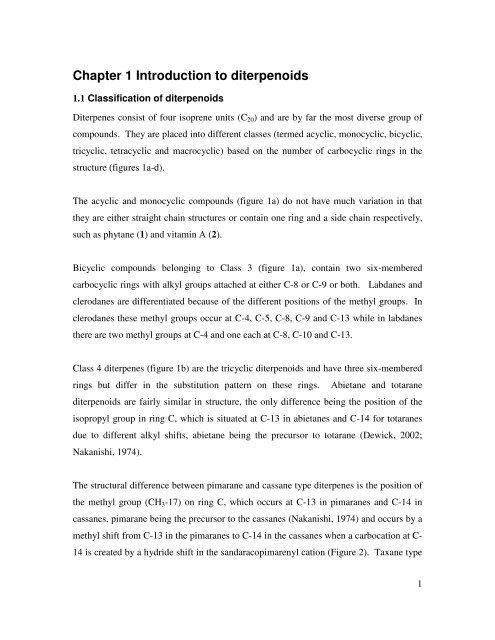university of kwazulu-natal faculty of science and agriculture school ...
university of kwazulu-natal faculty of science and agriculture school ...
university of kwazulu-natal faculty of science and agriculture school ...
You also want an ePaper? Increase the reach of your titles
YUMPU automatically turns print PDFs into web optimized ePapers that Google loves.
Chapter 1 Introduction to diterpenoids<br />
1.1 Classification <strong>of</strong> diterpenoids<br />
Diterpenes consist <strong>of</strong> four isoprene units (C20) <strong>and</strong> are by far the most diverse group <strong>of</strong><br />
compounds. They are placed into different classes (termed acyclic, monocyclic, bicyclic,<br />
tricyclic, tetracyclic <strong>and</strong> macrocyclic) based on the number <strong>of</strong> carbocyclic rings in the<br />
structure (figures 1a-d).<br />
The acyclic <strong>and</strong> monocyclic compounds (figure 1a) do not have much variation in that<br />
they are either straight chain structures or contain one ring <strong>and</strong> a side chain respectively,<br />
such as phytane (1) <strong>and</strong> vitamin A (2).<br />
Bicyclic compounds belonging to Class 3 (figure 1a), contain two six-membered<br />
carbocyclic rings with alkyl groups attached at either C-8 or C-9 or both. Labdanes <strong>and</strong><br />
clerodanes are differentiated because <strong>of</strong> the different positions <strong>of</strong> the methyl groups. In<br />
clerodanes these methyl groups occur at C-4, C-5, C-8, C-9 <strong>and</strong> C-13 while in labdanes<br />
there are two methyl groups at C-4 <strong>and</strong> one each at C-8, C-10 <strong>and</strong> C-13.<br />
Class 4 diterpenes (figure 1b) are the tricyclic diterpenoids <strong>and</strong> have three six-membered<br />
rings but differ in the substitution pattern on these rings. Abietane <strong>and</strong> totarane<br />
diterpenoids are fairly similar in structure, the only difference being the position <strong>of</strong> the<br />
isopropyl group in ring C, which is situated at C-13 in abietanes <strong>and</strong> C-14 for totaranes<br />
due to different alkyl shifts, abietane being the precursor to totarane (Dewick, 2002;<br />
Nakanishi, 1974).<br />
The structural difference between pimarane <strong>and</strong> cassane type diterpenes is the position <strong>of</strong><br />
the methyl group (CH3-17) on ring C, which occurs at C-13 in pimaranes <strong>and</strong> C-14 in<br />
cassanes, pimarane being the precursor to the cassanes (Nakanishi, 1974) <strong>and</strong> occurs by a<br />
methyl shift from C-13 in the pimaranes to C-14 in the cassanes when a carbocation at C-<br />
14 is created by a hydride shift in the s<strong>and</strong>aracopimarenyl cation (Figure 2). Taxane type<br />
1

















